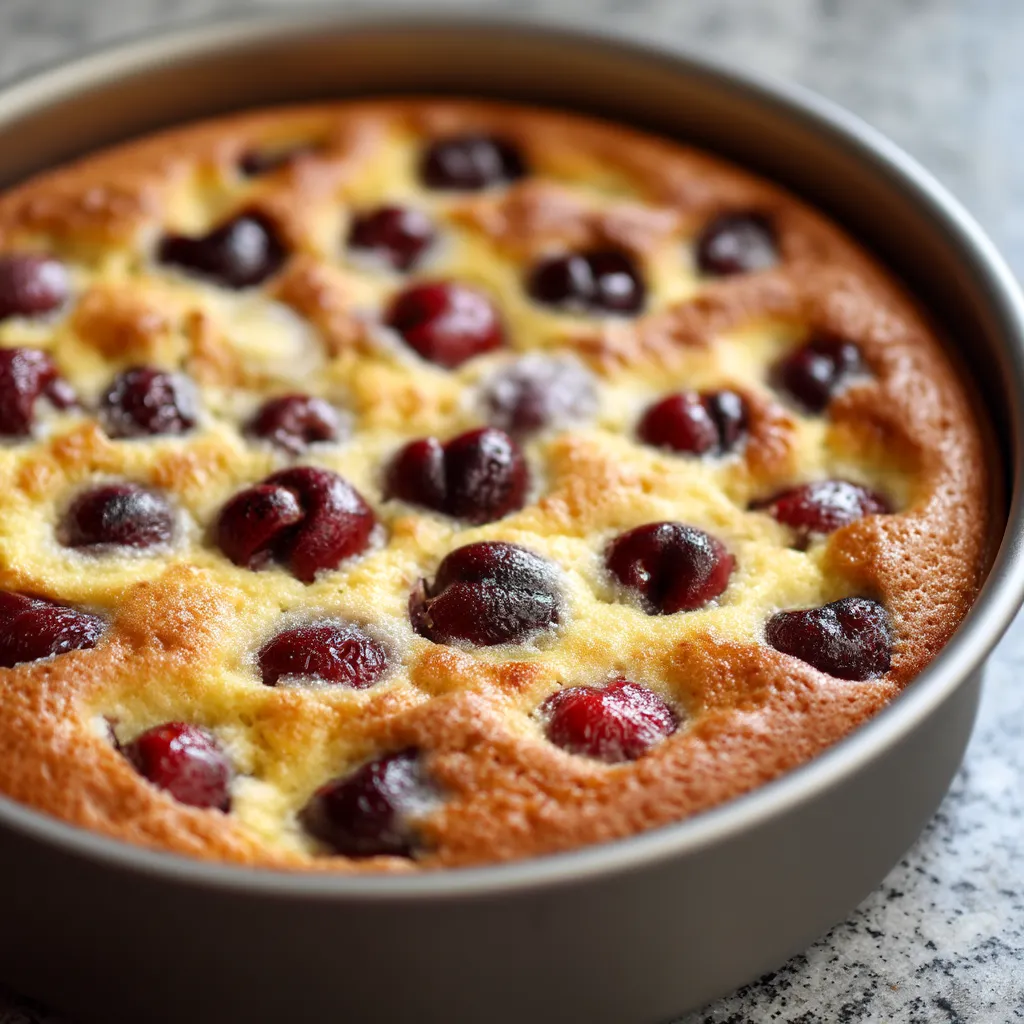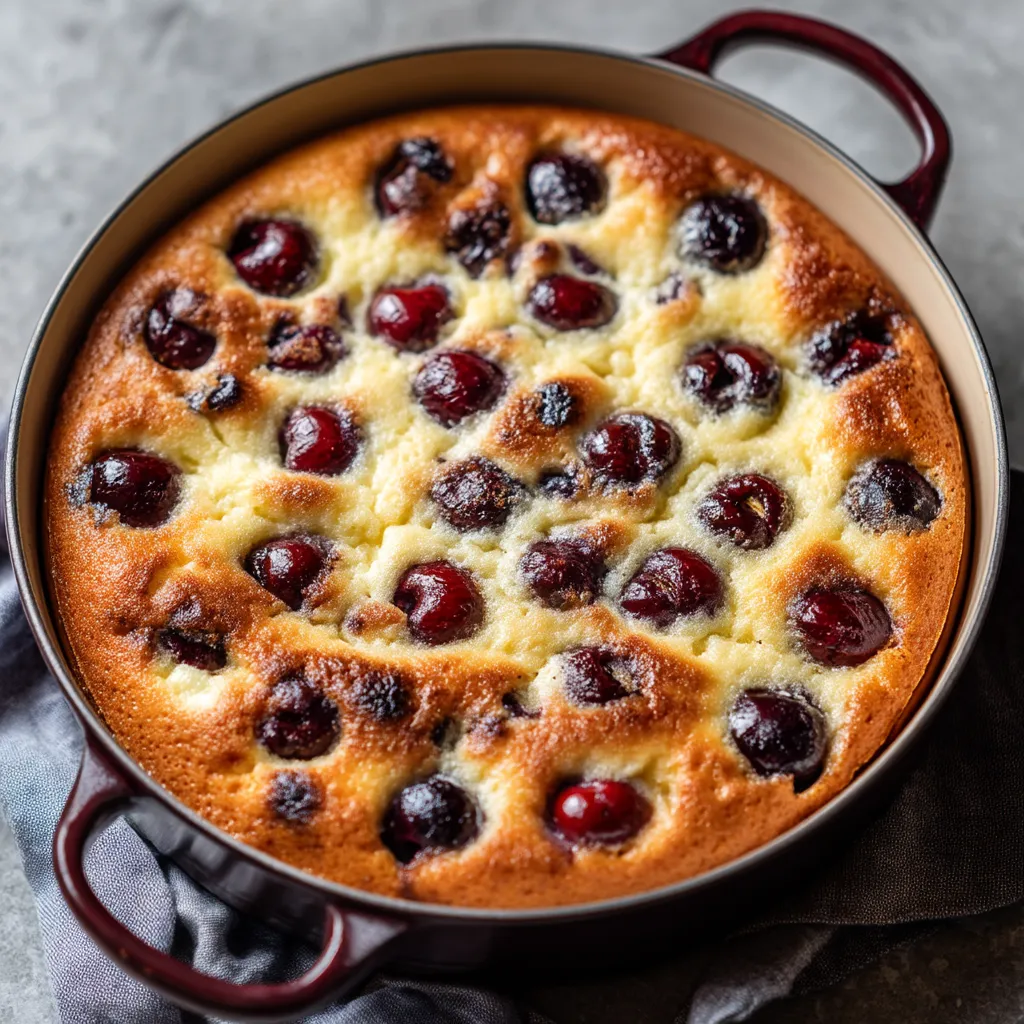 Save It
Save It This cherry clafoutis recipe has been my French secret weapon for hosting brunch gatherings for years. The beauty lies in its simplicity—a custardy batter poured over fresh cherries that transforms into an elegant dessert that never fails to impress guests while requiring minimal effort on your part.
I first discovered clafoutis during a summer in Provence where I watched my host mother effortlessly whip one up after dinner using cherries we had picked that morning. The memory of that first warm bite with slightly tart cherries suspended in sweet custard inspired me to recreate it for my own gatherings back home.
Ingredients
- Fresh or frozen sweet cherries: Adding natural sweetness and creating pockets of jammy goodness throughout the custard
- Large eggs: Providing structure and richness to create that signature custardy texture
- Granulated sugar: Balancing the tartness of the cherries without overwhelming them
- Vanilla extract: Offering warm aromatic notes that complement the fruit perfectly
- Almond extract: Optional but traditional and enhances the natural flavor in cherry pits
- All-purpose flour: Just enough to give structure while maintaining a creamy consistency
- Whole milk: Creates the base for a tender custard with proper richness
- Heavy cream: Adds extra silkiness and luxury to the final texture
- Lemon zest: Optional but adds a subtle brightness that wakens all the flavors
Step-by-Step Instructions
- Prepare the baking dish:
- Generously butter a large roasting pan or 9×13 inch baking dish, then dust with sugar. This creates a delicate caramelized crust around the edges that adds texture contrast and prevents sticking.
- Prepare the cherries:
- Toss your pitted cherries with a tablespoon each of flour and sugar. The light coating helps the cherries distribute evenly throughout the batter rather than sinking to the bottom during baking.
- Create the egg base:
- Whisk eggs and sugar vigorously until the mixture becomes pale yellow and slightly frothy. This incorporation of air helps achieve the perfect rise and texture in your clafoutis.
- Add flavorings:
- Incorporate the vanilla and almond extracts along with a pinch of salt. These seemingly small additions are crucial flavor builders that transform simple ingredients into something special.
- Incorporate the flour:
- Gradually add the flour while whisking constantly to prevent lumps from forming. A smooth batter now will ensure a silky finished texture.
- Add dairy:
- Slowly whisk in milk and cream to create a thin pancake-like batter consistency. The gradual addition prevents clumping and ensures even incorporation.
- Assemble and bake:
- Pour the batter over the prepared cherries and bake for 35 to 40 minutes until puffed and golden. The clafoutis will rise dramatically in the oven but settle as it cools.
- Cool before serving:
- Allow at least 20 minutes of cooling time before serving. This resting period lets the custard set properly for clean slicing.
 Save It
Save It My absolute favorite moment with this recipe was when my French teacher joined us for dinner and declared it reminded her of home. She explained that in her village, clafoutis was considered everyday food rather than special occasion fare—proving that sometimes the most comforting dishes can also be the most impressive.
Make Ahead Options
This clafoutis can be fully baked up to one day ahead and stored covered in the refrigerator. To serve, bring to room temperature or warm gently in a low oven for about 10 minutes. The flavor actually improves after the ingredients have had time to meld, making this an excellent stress-free entertaining option.
Cherry Options
While sweet cherries are traditional for clafoutis, sour cherries work beautifully if you increase the sugar slightly. In cherry season, I recommend using fresh fruit, but frozen cherries are an excellent year-round option—just thaw and drain them first to remove excess moisture. When using frozen cherries, adding a tablespoon of cornstarch to the cherry mixture helps absorb extra liquid that might otherwise make your clafoutis soggy.
 Save It
Save It Serving Suggestions
For a truly French experience, serve the clafoutis with lightly sweetened crème fraîche or whipped cream. A dusting of powdered sugar just before bringing it to the table adds an elegant finishing touch. For brunch gatherings, pair with strong coffee and fresh fruit for a balanced meal. The clafoutis can be served warm from the oven or at room temperature, making it flexible for any serving schedule.
Cultural Context
Clafoutis originated in the Limousin region of France as a humble farmhouse dessert that utilized seasonal cherries. Traditionally made with unpitted cherries because the pits impart an almond-like flavor during baking, modern versions typically use pitted cherries for convenience. The name comes from the Occitan word "clafir" meaning "to fill," referring to how the cherries fill the batter. While purists insist a true clafoutis can only be made with cherries, variations with other fruits are properly called "flaugnarde."
Common Questions About Recipes
- → Can I use frozen cherries instead of fresh?
Yes, you can use frozen cherries with excellent results. There's no need to thaw them first—just toss the frozen cherries with flour and sugar as directed, then proceed with the recipe. The baking time may need to be extended by 5-7 minutes.
- → Why is my clafoutis deflating after baking?
This is completely normal! Clafoutis naturally puffs up during baking like a soufflé, but will settle as it cools. The custard will still have a wonderful texture, and this deflation is characteristic of an authentic clafoutis.
- → Can I make cherry clafoutis in advance?
Yes, you can make it a few hours ahead of serving. Let it cool completely, then cover with foil. Gently reheat in a 300°F (150°C) oven for about 10-15 minutes before serving. It's also delicious at room temperature.
- → Can I substitute other fruits for the cherries?
Absolutely! While cherries are traditional, you can use berries, sliced peaches, plums, or apricots. Just ensure the quantity is roughly equivalent to the 5 cups of cherries called for in the original recipe.
- → Is it necessary to pit the cherries?
Traditionally, cherries in clafoutis were left unpitted, as the pits impart a subtle almond flavor. However, for convenience and guest comfort, pitting is recommended. If using unpitted cherries, be sure to warn your guests!
- → Can I make this dairy-free?
Yes, you can substitute the milk and cream with plant-based alternatives. Full-fat coconut milk or a combination of almond milk and coconut cream works well, though it will slightly alter the flavor profile.